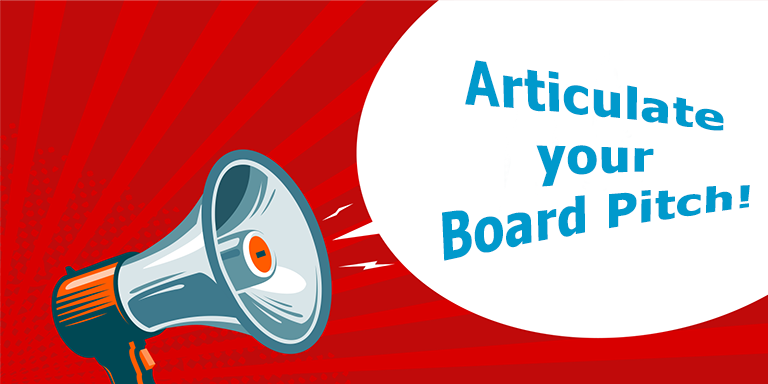A Board Profile template that gets results

Prior to applying for board roles or crafting your board resume, it is crucial to compose a compelling board profile that increases your chances of landing an interview. This task presents a significant hurdle for most aspiring independent board members. However, once completed, you can confidently express your unique contributions and separate yourself from others competing for the role.
What is a board profile?
As experienced executives, you will all be familiar with an executive profile or summary. It is a concise, often short, biography outlining your professional expertise, skills, achievements, and qualifications. It can be found on the websites of companies you work for or with, attached to media releases and articles, listed in conference and event materials, and incorporated in your resume and LinkedIn profile.
For many, the broader purpose of a board profile may seem the same, but the content of your board profile should be very different from your executive profile. It must present your experience, value, achievements, and skills in relation to serving on a board or contributing at the board level. Board member roles are not hands-on operational roles. You must show that you can oversee and make decisions as part of a strategic team.
A board member profile that gets results must address the five (5) core elements that chairs want to see in board candidates: that they have prior governance experience, strategic executive skills, valuable networks and connections, demonstrable passion, and a favourable cultural fit. Industry experience, governance qualifications and diversity are other elements to consider when creating a board profile.
There should be no such thing as a static board profile. Your board member profile should be customized slightly, depending on the reader and organization you pitch to or represent. If you seek an independent board seat, you must tailor the content to suit the type of board and organisation you want to serve. Essentially, you are telling them why you should be appointed.
Your formal board profile template
You must be confident when articulating your board profile in formal and informal settings, both verbally and in writing. This begins with crafting a comprehensive written profile that can be condensed or tailored to fit specific needs.
Here is the template I use when assisting aspiring and experienced independent board members to write their board profiles.
The Opening Sentence
A compelling way to open your written profile is to tell people you have done the role. This is easy to do if you have already had a board seat. If you haven’t, a bit of creativity may be required. By creative, I do not mean misrepresenting your level of board experience. What I do recommend is to consider leveraging any committee, governance, advisory, or board-level expertise you have.
Support your introductory sentence with the amount of experience you have in this work. Within the same sentence, you should also list your past executive titles such as CEO, Director, Accountant, Lawyer, HR Director or similar. Only use your title, not a description of the role. The aim of this element is to provide comfort that you have the skills required at the board level.
You must be extremely clear when articulating your board-level experience; don’t let the audience make assumptions. First impressions can make a huge difference, particularly when multiple candidates compete for one board seat.
Ideally, you want to begin this sentence with…
“I am a Non-Executive (or equivalent board-level title that you have, such as Independent Director, Audit Committee Member, Voluntary Board Member).”
The 2nd & 3rd Sentences
A compelling opening statement needs to be supported with details about your experience. The key here is to show the value of your experience to boards and their work. Show that you are an aspiring independent director and a successful board-level professional.
To address this specifically in your board profile, you must clearly understand how your unique skills and experience can contribute at the board level. Being vague here is not an option. You can not be everything to everyone. The reader must understand what you have achieved and can achieve for them.
These two sentences should follow this type of format..
“At board level, what I do is…I do that by…”
Your first three sentences are key. They start strong by stating what you have achieved on and with boards. They provide confidence that you know your value and potential at the board level, and allow the board to foresee how you can help.
The 4th Sentence
This sentence should furnish the details of your experience at the board level. The most powerful way to do this is by providing examples of strategic success. For example, consider stating…
“At the board level, my highlights encompass (insert the roles and positions you have held on boards)”. Then, point out what your contribution was to each.
Remember, this is about concise writing, so you must be selective. Just include your most significant or most relevant successes. To achieve this, consider reflecting on your accomplishments through these three approaches:
What were the reasons you were appointed to the role, and have you fulfilled them?
What reasons would you give the Chair if you were to ask for a pay rise? (This, of course, is a role-play scenario to consider your ROI, the benefit or return of the board’s investment in you.)
Align your achievements with the organization’s accomplishments during your tenure as a director.
The 5th Sentence
This sentence should be more straightforward to craft than the others, as much of the information will already be present in your executive CV or profile. Essentially, it is a summary of your relevant executive experience. Focus first on your highest-profile roles, with the highest-profile organizations. Not everything should be included here, as other relevant roles will be included in the body of your board resume. So, if you are currently a consultant but were previously a CEO or director, lead with information about your highest profile or most relevant board-level positions first.
You may incorporate measurable achievements from your executive roles if relevant. You might start with a sentence like this…
“As CEO of ACB Corporation, I …”
The Final Sentence
Boards value intelligence and education, so it’s important to illustrate these qualities. If you have an MBA, include it here. If you have a degree, include it here. Likewise, if you have completed some form of governance training, include it.
Don’t undervalue the significance of a governance qualification; if you possess one, this is your opportunity to showcase it.
You should also list the names of relevant industries or governance bodies you are a member of. They demonstrate your commitment to governance and maintaining relevance. If your educational qualifications are not particularly strong or relevant, it is best to omit them.
In Summary
Your board profile is the cornerstone of communication throughout every stage of the board appointment process, both formal and informal. It will also serve as the foundation of your ‘elevator pitch’ when introducing yourself to potential contacts. Additionally, it serves as the foundation for drafting any board application and is integral to your board cover letter and board CV.
Crafting a compelling board profile may take time, and since it should be tailored for each recipient and setting, ensure you are flexible and able to adjust it when required. Ensure that your board profile convincingly addresses the question, “What makes you the ideal candidate for this board?” You will compel them to appoint you by clearly responding to this.
Related Articles
What are the selection criteria for independent board members?
About the Author
David Schwarz is CEO & Founder of Board Appointments. He has over a decade of experience in putting people on boards as an international headhunter and recruiter. He has interviewed hundreds of directors and placed hundreds into some of the most significant public, private and NFP director roles in the world.







Responses